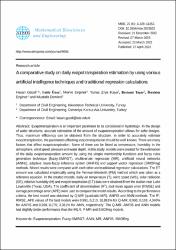| dc.contributor.author | Güzel, Hasan | |
| dc.contributor.author | Üneş, Fatih | |
| dc.contributor.author | Erginer, Merve | |
| dc.contributor.author | Kaya, Yunus Ziya | |
| dc.contributor.author | Taşar, Bestami | |
| dc.contributor.author | Erginer, İbrahim | |
| dc.contributor.author | Demirci, Mustafa | |
| dc.date.accessioned | 2023-12-13T05:27:54Z | |
| dc.date.available | 2023-12-13T05:27:54Z | |
| dc.date.issued | 2023 | en_US |
| dc.identifier.citation | Güzel, H., Üneş, F., Erginer, M., Kaya, Y.Z., Taşar, B., Erginer, İ., Demirci, M. (2023). A comparative study on daily evapotranspiration estimation by using various artificial intelligence techniques and traditional regression calculations. Mathematical Biosciences and Engineering, 20 (6), pp. 11328-11352. | en_US |
| dc.identifier.issn | 1547-1063 | |
| dc.identifier.issn | 1551-0018 | |
| dc.identifier.uri | https://hdl.handle.net/20.500.12508/2640 | |
| dc.description.abstract | Evapotranspiration is an important parameter to be considered in hydrology. In the design of water structures, accurate estimation of the amount of evapotranspiration allows for safer designs. Thus, maximum efficiency can be obtained from the structure. In order to accurately estimate evapotranspiration, the parameters affecting evapotranspiration should be well known. There are many factors that affect evapotranspiration. Some of these can be listed as temperature, humidity in the atmosphere, wind speed, pressure and water depth. In this study, models were created for the estimation of the daily evapotranspiration amount by using the simple membership functions and fuzzy rules generation technique (fuzzy-SMRGT), multivariate regression (MR), artificial neural networks (ANNs), adaptive neuro-fuzzy inference system (ANFIS) and support vector regression (SMOReg) methods. Model results were compared with each other and traditional regression calculations. The ET amount was calculated empirically using the Penman-Monteith (PM) method which was taken as a reference equation. In the created models, daily air temperature (T), wind speed (WS), solar radiation (SR), relative humidity (H) and evapotranspiration (ET) data were obtained from the station near Lake Lewisville (Texas, USA). The coefficient of determination (R2), root mean square error (RMSE) and average percentage error (APE) were used to compare the model results. According to the performance criteria, the best model was obtained by Q-MR (quadratic-MR), ANFIS and ANN methods. The R2, RMSE, APE values of the best models were 0,991, 0,213, 18,881% for Q-MR; 0,996; 0,103; 4,340% for ANFIS and 0,998; 0,075; 3,361% for ANN, respectively. The Q-MR, ANFIS and ANN models had slightly better performance than the MLR, P-MR and SMOReg models. | en_US |
| dc.language.iso | eng | en_US |
| dc.publisher | American Institute of Mathematical Sciences | en_US |
| dc.rights | info:eu-repo/semantics/openAccess | en_US |
| dc.subject | ANFIS | en_US |
| dc.subject | ANN | en_US |
| dc.subject | Evapotranspiration | en_US |
| dc.subject | Fuzzy-SMRGT | en_US |
| dc.subject | MR | en_US |
| dc.subject | SMOReg | en_US |
| dc.subject.classification | Prediction | |
| dc.subject.classification | Flood Forecasting | |
| dc.subject.classification | Water Tables | |
| dc.subject.classification | Social Sciences - Climate Change - Flood Routing | |
| dc.subject.other | Animals | |
| dc.subject.other | Artificial intelligence | |
| dc.subject.other | Hominidae | |
| dc.subject.other | Neural networks | |
| dc.subject.other | Computer | |
| dc.subject.other | Water | |
| dc.subject.other | Wind | |
| dc.subject.other | Fuzzy inference | |
| dc.subject.other | Fuzzy neural networks | |
| dc.subject.other | Fuzzy systems | |
| dc.subject.other | Mean square error | |
| dc.subject.other | Membership functions | |
| dc.subject.other | Regression analysis | |
| dc.subject.other | Wind speed | |
| dc.subject.other | Adaptive neuro-fuzzy inference | |
| dc.subject.other | Adaptive neuro-fuzzy inference system | |
| dc.subject.other | Daily evapotranspirations | |
| dc.subject.other | Fuzzy-SMRGT | |
| dc.subject.other | Modeling results | |
| dc.subject.other | Multivariate regression | |
| dc.subject.other | Neuro-fuzzy inference systems | |
| dc.subject.other | Root mean square errors | |
| dc.subject.other | SMOReg | |
| dc.subject.other | Wind speed | |
| dc.title | A comparative study on daily evapotranspiration estimation by using various artificial intelligence techniques and traditional regression calculations | en_US |
| dc.type | article | en_US |
| dc.relation.journal | Mathematical Biosciences and Engineering | en_US |
| dc.contributor.department | Mühendislik ve Doğa Bilimleri Fakültesi -- İnşaat Mühendisliği Bölümü | en_US |
| dc.identifier.volume | 20 | en_US |
| dc.identifier.issue | 6 | en_US |
| dc.identifier.startpage | 11328 | en_US |
| dc.identifier.endpage | 11352 | en_US |
| dc.relation.publicationcategory | Makale - Uluslararası Hakemli Dergi - Kurum Öğretim Elemanı | en_US |
| dc.contributor.isteauthor | Güzel, Hasan | |
| dc.contributor.isteauthor | Üneş, Fatih | |
| dc.contributor.isteauthor | Erginer, Merve | |
| dc.contributor.isteauthor | Taşar, Bestami | |
| dc.contributor.isteauthor | Erginer, İbrahim | |
| dc.contributor.isteauthor | Demirci, Mustafa | |
| dc.relation.index | Web of Science - Scopus - PubMed | en_US |
| dc.relation.index | Web of Science Core Collection - Science Citation Index Expanded | |
















